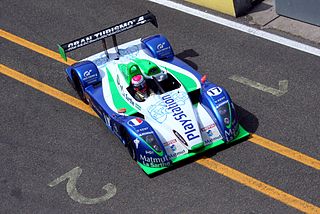
Roy Francesco Salvadori was a British racing driver and motorsport executive, who competed in Formula One from 1952 to 1962. In endurance racing, Salvadori won the 24 Hours of Le Mans in 1959 with Aston Martin.

The North American Racing Team (NART) is a motorsport racing team founded in 1958. It was created by businessman Luigi Chinetti to promote the Ferrari marque in North America through success in endurance racing.
Jeff Altenburg is a professional race car driver born in the USA. He has won sixteen national championships in both amateur and professional racing.

Road Atlanta is a 2.540 mi (4.088 km) road course located just north of Braselton, Georgia, United States. The facility is utilized for a wide variety of events, including professional and amateur sports car and motorcycle races, racing and driving schools, corporate programs and testing for motorsports teams. The track has 12 turns, including the famous "esses" between turns three and five; and Turn 12, a downhill, diving turn. The track is owned by IMSA Holdings, LLC through its subsidiary Road Atlanta, LLC, and is the home to the Petit Le Mans, as well as AMA motorcycle racing, and smaller events throughout the year. Michelin acquired naming rights to the facility in 2018.

The 1958 1000 km Buenos Aires took place on 26 January, on the Autódromo Municipal-Avenida Paz,. It was the fifth running of the race, and once again, it was opening round of the F.I.A. World Sports Car Championship. For this event, it returned to the Autódromo, after having a one-off race at the Circuito de la Costanera Norte, however its layout was not generally well received.
The Springfield ARCA 100 is an ARCA Menards Series stock car race held annually on the Illinois State Fairgrounds Racetrack during the Illinois State Fair.

Lotec is a German sports car manufacturer, founded in 1962 by Kurt Lotterschmid. By 1969, the firm began building race cars, and would turn their attention to modifications for Porsches in 1975. In 1983, they began to create aftermarket aerodynamic and performance parts for Mercedes-Benz cars and Ferrari cars.
Mobile International Speedway is a 0.500 mi (0.805 km) paved oval track along U.S. Highway 90 in Irvington, Mobile County, Alabama, United States. It was built by Walter "Skip" Wetjen, and opened in 1965.

The Courage C60 was a Le Mans Prototype (LMP) racing car built by Courage Compétition in 2000, and used in international sports car races until 2006. A replacement for the Courage C52, it was Courage's first all-new prototype since the Courage C41 was built in 1994.

The March 86G was a Group C and IMSA GTP sports racing car built by March Engineering. Built as simply a chassis with no engine, it was branded as one of three cars, the BMW GTP, the Buick Hawk or the Nissan R86V depending on which engine was placed in the chassis and which team was running it. There were a number of subtle bodywork changes to reflect the manufacturer which ran the car.
Pat Griffith was an English racing driver, who raced for the works Aston Martin team during the early 1950s, winning the 1953 RAC Tourist Trophy.

The Ligier JS2 is a mid-engined sports coupé that was built by Ligier in the French commune of Abrest near Vichy in the department of Allier between 1971 and 1975. Road-going and competition versions were built.
The following is an overview of the events of 1962 in motorsport including the major racing events, motorsport venues that were opened and closed during a year, championships and non-championship events that were established and disestablished in a year, and births and deaths of racing drivers and other motorsport people.

The OSCA MT4, also spelled the O.S.C.A. MT4 or Osca MT4, is an Italian sports car prototype, designed, developed, and made by Officine Specializzata Costruzioni Automobili, between 1948 and 1956, but was raced and used in active competition until 1966.
The Chevron B71 was a sports prototype race car, designed, developed and built by Chevron, for IMSA's World Sports Car (WSC) class, in 1995. A modified development of this car, called the Kopf Keiler KII, closely based on the Chevron B71, debuted at the 1997 24 Hours of Daytona.
The RGS Mirage GT1 is a grand tourer-style race car designed and built by RGS Motorsport. Built to GT1 regulations, it competed in the British GT Championship from 1997 to 1998 before contesting select rounds of the All Japan Grand Touring Car Championship in 2000 and 2003. The Mirage GT1 is significant for being constructed from kit car panels to look indistinguishable from the Lamborghini Countach, making it unique amongst top category GT race cars.

The Nissan Skyline Turbo C is a Group C prototype sports car developed by Garage Le Mans for the 1983 All Japan Endurance Championship and Fuji Long Distance Series. While used as a marketing tool for the R30 Skyline, the Skyline Turbo C has no parts commonality or shared origin with the street car. The engine is equipped with Nissan's LZ20B type.

The 2001 1000 km di Monza was the second race for the 2001 FIA Sportscar Championship season held at Autodromo Nazionale Monza and ran for 1,000 kilometers. It took place on April 22, 2001.

The 1998 Sports Car Grand Prix of Road Atlanta was the fourth race for the 1998 IMSA GT Championship season. It took place on June 21, 1998, at Road Atlanta and ran for three hours and 45 minutes.

The 1998 Homestead 2 Hours 15 Minutes was the second race for the 1998 United States Road Racing Championship season. It took place on May 17, 1998, at Homestead–Miami Speedway.











